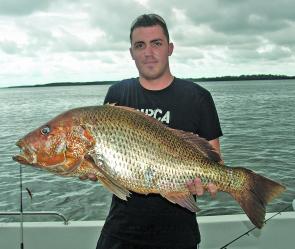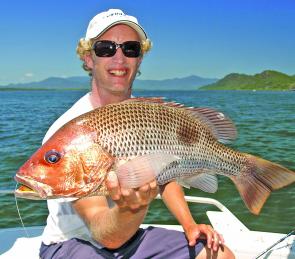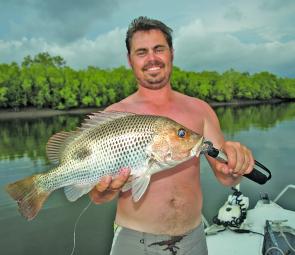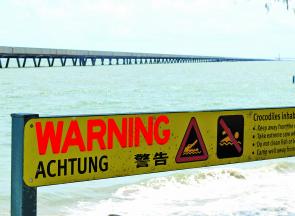Over the warmer months one of the tropic’s most sought after species is the golden snapper, formerly known as fingermark. This is no surprise as these fish, Lutjanus johnii, can be targeted in a variety of environments and can reach metre-length sizes.
In this article I will cover some of the areas where golden snapper can be found and even drop a few little known facts about this hard pulling, dirty fighting freight train of the north, and Australia’s answer to Papua New Guinea’s black bass.
Golden snapper are classed as a coral reef fish that is associated with turbid water. This definition indicates that adults spend their lives offshore returning to coastal waters to spawn, where the young will begin their lives living in the sanctuary of tidal estuaries.
While offshore, golden snapper can be found in waters up to 80m deep and are often found around prominent underwater structures. They undergo a prolonged spawning period from early September to late April, which sees them move from deep water to the relative shallow waters of the coastline where spawning occurs.
As they make their way towards the spawning grounds they often school up on structures along the way, such as wrecks and pinnacles. It’s during this period that they are susceptible to over fishing.
As with most species, large golden snapper are mostly female that mature at a size of 63cm; males mature much younger at a size of around 47cm. They are believed to live for over 20 years and reach sizes around 1m but are more commonly caught around the 80cm mark.
A well known problem facing golden snapper is the effects of barotrauma when caught in depths greater than 10m. Barotrauma is physical damage caused by a significant change in atmospheric pressure and, in the case of golden snapper, it is caused by the rapid or extreme ascent to the surface when fighting and landing the fish. This damage mainly occurs to the swim bladder as gases rapidly expand; this makes it near impossible for the fish to swim back below the surface and in extreme cases the stomach is forced out the mouth and the eyes bulge out of the sockets causing death.
To release golden snapper with only minor barotrauma you need to vent the swim bladder by releasing air with a release tool. Alternatively, you can also make a device that allows the fish to be lowered back to the deeper water equalising the pressure and releasing it at this depth. Generally very little is known about the biology of this species and more research will be needed to manage into the future.
The geographical locations of golden snapper range from Indo-West Pacific, inhabiting the tropical inshore waters from East Africa to Fiji and just south of Japan. In Australian waters they range from Hervey Bay on the east coast, although this population is relatively small. Further north the population explodes and is extremely healthy from the Capricorn Coast north.
Golden snapper are common throughout the tropics and are found in the Gulf of Carpentaria and across the top of Australia over to the west coast. A particular stronghold of this species lies from Cape Cleveland in Townsville up through the Palm Island group to the waters in and around Hinchinbrook Island with Lucinda to the south and Cardwell to the north.
Golden snapper inhabit a wide variety of environments and, excluding freshwater, can be found from coastal tidal creeks out to the deep waters fringing the coral reefs. The key factor to finding golden snapper in these environments is structure and, without a doubt, their most favoured structure of all is rock.
When looking for these fish in tidal estuaries it’s always a good place to start with any visible rocky shorelines as these areas often extend out underwater. From here it pays to use your sounder to search out any submerged rock bars that otherwise would remain hidden.
Once located golden snapper show up quite well on the sounder due to their large swim bladder, which bounces back a strong sonar signal. They will hold on larger snags, such as fallen timber, but you really can’t go past a cluster of rock. In some creeks finding scattered rocky bottoms or rock bars often coincide with the mouth of the system and these areas are well worth exploring.
Moving out of the creeks you start to venture in to the domain of rocky headlands with submerged pinnacles or bommies close by. Depending on the water depth in the vicinity of the headland and how close the next patch structure is will determine whether the fish will hold close to shore or hang further out on the underwater extensions of the headland.
Low light conditions will often see golden snapper move in closer to the deeper water surrounding a headland and can be tight to the structure at times. More commonly they will hold on the wider more prominent solitary pinnacles or bommies; searching out these areas is worth the time and effort.
In conjunction with a headland comes shelter from winds. Man-made breakwalls are often built in these areas to make harbours and these extensions can fish just as well as any natural habitat.
Likewise, golden snapper can’t go past other man-made structures, like pylons of a jetty, as they provide numerous amounts of ambush points and attract an endless supply of prey items. Areas like this create big breaks in the current and golden snapper will often hold in these breaks waiting for food to come to them.
Wrecks can also hold golden snapper at different periods of the year, depending on its location. When migrating fish move from the deep grounds heading for the shallows to spawn they use wrecks as a stopover. And also on their way back after spawning.
This happens year after year in the waters around Hinchinbrook Island during the annual spawning migration. In this area golden snapper migrate from the outer reefs and show up on the man-made sugar loading jetty and on a couple of wrecks between the reefs and the island as they head for the relatively sheltered waters. I can only assume after seeing them school en masse here for nearly 10 years this is a place where spawning occurs.
Finding these mass aggregations can be a problem as netters can take advantage of the schooling nature and easily overfish spawning schools. Every year I hear more and more shocking stories of these breeding golden snapper killed un-relentlessly during a crucial part of their life cycle when stocks are supposed to be replenished for the future survival of a species.
Nevertheless, golden snapper populations are healthy for now and finding them is not too hard with the right information to get you started. So go out and have a go at finding some goldens.
Reads: 9570
Adam Young with a prime example of a truly large golden snapper measuring 95cm from the Hinchinbrook Channel.

Artie Rienstra with a typical size fish that would be sexually mature and taking part in spawning aggregations.

Jake Lane with a quality example of a creek specimen taken north of Townsville.

Tarrant Mathers with an old female capable of producing thousands of young each spawn.

The aggressive nature of golden snapper means even new-comers to the species can be successful throwing lures at them.

The author with a solid fish caught from a man-made structure that is used by golden snapper over the spawning season.

The mountainous backdrop to the Hinchinbrook Channel. With contours like this above and below the surface, it's not hard to see why this area holds golden snapper.

The iconic sugar loading jetty in Lucinda is a renown hotspot – all 5.6km of it!




